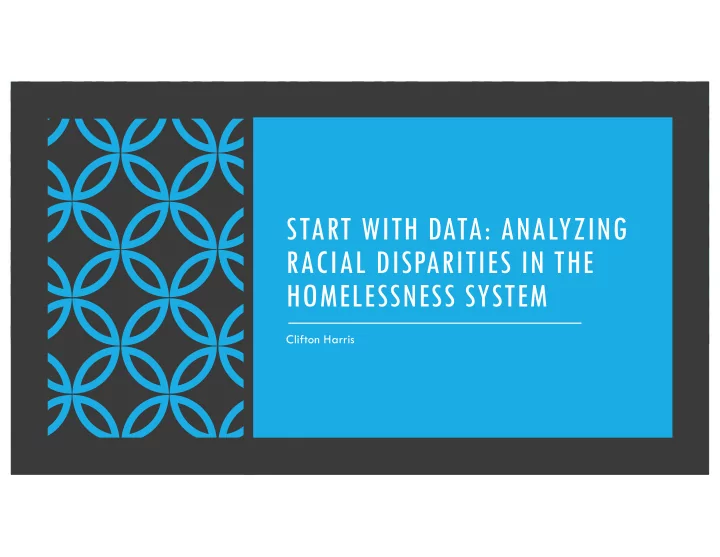

START WITH DATA: ANALYZING RACIAL DISPARITIES IN THE HOMELESSNESS SYSTEM Clifton Harris
Could current data identify racial disparities in our system? Does HMIS data reflect the current housing and income factors in our community? WHERE WE STARTED If the homeless data was significantly different than the other community data, would we be able to determine the cause of that? If the data is comparable, is that sufficient evidence that there is no disparity?
What Does The Data Tell Us?
Am American Native Na Bl Black or Indian o In or Hawa Ha waiian or Alaska Al Other Pacific Ot Multiple Mu African Af 2017 2017 To Total Am American White Wh As Asian Na Native Is Islander Races Ra Hi Hispanic Em Emergency Sh Shelter 5584 5584 3154 3154 1706 1706 30 30 11 11 16 16 86 86 149 149 2017 HMIS % 56% 56% 31% 31% 1% 1% 0% 0% 0% 0% 2% 2% 3% HOMELESS AND St Street 1902 1902 1313 1313 440 440 8 7 5 38 38 38 38 Outreach Ou PLACEMENT 69% 69% 23% 23% 0% 0% 0% 0% 0% 0% 2% 2% 2% 2% DATA Pe Permanent Su Supportive Ho Housing 2953 2953 2171 2171 634 634 15 15 5 5 69 69 55 55 % 74% 74% 21% 21% 1% 1% 0% 0% 0% 0% 2% 2% 2% 2% Ra Rapid 1562 1562 1240 1240 266 266 7 3 4 27 27 49 49 Rehousing Re % 79% 79% 17% 17% 0% 0% 0% 0% 0% 0% 2% 2% 3% 3%
HOW IS NEW ORLEANS DOING? Nearly half of all black families (47 percent) earn less than $25,237 a year. The same was true for only 14 percent of white households. Compared with white households, black households in New Orleans earned 63 percent less on the median. Hispanic households earned 47 percent less. Nearly half of all African-American children live in poverty. That is true for only 9 percent of white children . 41 percent of black households in New Orleans own their homes, compared with 54 percent of white households. More than half of all renters in New Orleans spent 35 percent of their income or more on housing in 2016. Nearly 60 percent of black residents in New Orleans rent. Source: Plyer , Allison, and Lamar Gardere. The New Orleans Prosperity Index: Tricentennial Edition , Data Center , 11 Apr. 2018, www.datacenterresearch.org/reports_analysis/prosperity-index/.
UNITY RACIAL AND ETHNIC DISPARITIES TASK FORCE Comprised of employees from different staff levels, Formed in August 2018 service types and sub populations served within the COC. Create an action plan to Analyze COC data to monitor and address identify potential racial and ethnic disparities disparities
Expand outreach efforts in geographic areas with higher concentrations of underrepresented groups.in to underserved communities. To develop educational material on creating greater racial and ethnic diversity for homelessness in the CoC. Examine emergency shelters and how race disparities play in access. TASK FORCE Review coordinated entry processes to understand their impact on people of different races and ethnicities GOALS AND experiencing homelessness. ACTION PLAN Review By-Name List and Housing placements to identify potential disparities Create Data Collection plan
• Improve outreach data to include non COC funded outreach program that serves Central Business District and French Quarter. • Use Racial Equity Tool to track individual emergency shelters. • Racial and ethnic breakdown of landlords that participate in permanent housing placement. • Track race and equity data on youth and gender • Include 3 to 5 assessment questions to HMIS entry to take further look into TASK FORCE DATA client experiences within homeless services. COLLECTION PLAN
When did you originally move to the New Orleans area? Zip Code or City of Last Permanent DISPARITY Address RELATED Are you more comfortable staying on the street versus a shelter? ASSESSMENT • If so why? QUESTIONS Primary reason for homeless? Have you ever been in foster care?
Limited resources to collect data Current required data for federal reporting and coordinated entry Scope of data focused on outcomes that homelessness system can directly change POTENTIAL CONCERNS AND CHALLENGES
THANK YOU CONTACT CLIFTON J. HARRIS III (504) 895-5550 CHARRIS@VIALINK.ORG INFORMATION:
Recommend
More recommend